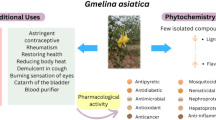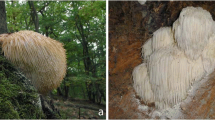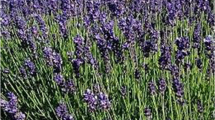Abstract
Chlorogenic acid (CGA) is a natural organic phenolic compound that is found in many plants, fruits and vegetables. CGA has beneficial bioactivities and strong therapeutic effects in inflammatory processes. CGA-rich fractions have analgesic activity but CGA has not been tested previously in neuropathic pain, which results from tissue damage, inflammation or injury of the nervous system. Chronic constrictive nerve injury (CCI) is a peripheral neuropathic pain model which initiates an inflammatory cascade. We aimed to determine possible antihyperalgesic effects of CGA in neuropathic pain. Our study showed for the first time that CGA [50, 100 and 200 mg/kg; intraperitoneally (i.p.)] produced significant dose- and time-dependent antihyperalgesic activity in CCI-induced neuropathic pain. In addition, chronic administration of CGA (100 mg/kg/day; i.p. for 14 days) prevented the development of mechanical hyperalgesia and attenuated CCI-induced histopathological changes. On the other hand, CGA (200 mg/kg) did not affect falling latencies of rats in the rota rod test. Hence, CGA might represent a novel potential therapeutic option for the management of neuropathic pain.






Similar content being viewed by others
References
Calixto JB, Beirith A, Ferreira J, Santos AR, Filho VC, Yunes RA (2000) Naturally occurring antinociceptive substance from plants. Phytother Res 14:401–418
Manach C, Scalbert A, Morand C, Rémésy C, Jiménez L (2004) Polyphenols: food sources and bioavailability. Am J Clin Nutr 79:727–747
Huang WY, Cai YZ, Zhang Y (2010) Natural phenolic compounds from medicinal herbs and dietary plants: potential use for cancer prevention. Nutr Cancer 62:1–20
Kim YC (2010) Neuroprotective phenolics in medicinal plants. Arch Pharm Res 33:1611–1632
Scalbert A, Manach C, Morand C, Rémésy C, Jiménez L (2005) Dietary polyphenols and the prevention of diseases. Crit Rev Food Sci Nutr 45:287–306
Clifford MN (1999) Chlorogenic acids and other cinnamates—nature, occurrence and dietary burden. J Sci Food Agric 79:362–372
Trugo LC, Macrae R (1984) A study of the effect of roasting on the chlorogenic acid composition of coffee using HPLC. Food Chem 15:219–227
Graham HN (1992) Green tea composition, consumption, and polyphenol chemistry. Prev Med 21:334–350
Sato Y, Itagaki S, Kurokawa T, Ogura J, Kobayashi M, Hirano T, Sugawara M, Iseki K (2011) In vitro and in vivo antioxidant properties of chlorogenic acid and caffeic acid. Int J Pharm 403:136–138
dos Santos MD, Almeida MC, Lopes NP, de Souza GE (2006) Evaluation of the anti-inflammatory, analgesic and antipyretic activities of the natural polyphenol chlorogenic acid. Biol Pharm Bull 29:2236–2240
Abraham SK, Schupp N, Schmid U, Stopper H (2007) Antigenotoxic effects of the phytoestrogen pelargonidin chloride and the polyphenol chlorogenic acid. Mol Nutr Food Res 51:880–887
Weng CJ, Yen GC (2012) Chemopreventive effects of dietary phytochemicals against cancer invasion and metastasis: phenolic acids, monophenol, polyphenol, and their derivatives. Cancer Treat Rev 38:76–87
Chauhan PS, Satti NK, Sharma P, Sharma VK, Suri KA, Bani S (2012) Differential effects of chlorogenic acid on various immunological parameters relevant to rheumatoid arthritis. Phytother Res 26(8):1156–1165
Zhang X, Huang H, Yang T, Ye Y, Shan J, Yin Z, Luo L (2010) Chlorogenic acid protects mice against lipopolysaccharide-induced acute lung injury. Injury 41:746–752
Gorzalczany S, Marrassini C, Miño J, Acevedo C, Ferraro G (2011) Antinociceptive activity of ethanolic extract and isolated compounds of Urtica circularis. J Ethnopharmacol 134:733–738
Marrassini C, Acevedo C, Miño J, Ferraro G, Gorzalczany S (2010) Evaluation of antinociceptive, antinflammatory activities and phytochemical analysis of aerial parts of Urtica urens L. Phytother Res 24:1807–1812
Yonathan M, Asres K, Assefa A, Bucar F (2006) In vivo anti-inflammatory and anti-nociceptive activities of Cheilanthes farinosa. J Ethnopharmacol 108:462–470
Moalem G, Tracey DJ (2006) Immune and inflammatory mechanisms in neuropathic pain. Brain Res Rev 51:240–264
Bennett GJ, Xie YK (1988) A peripheral mononeuropathy in rat that produces disorders of pain sensation like those seen in man. Pain 33:87–107
Muthuraman A, Singh N (2011) Attenuating effect of Acorus calamus extract in chronic constriction injury induced neuropathic pain in rats: an evidence of anti-oxidative, anti-inflammatory, neuroprotective and calcium inhibitory effects. BMC Complement Altern Med 22:11–24
Zimmermann M (1983) Ethical guidelines for investigations of experimental pain in conscious animals. Pain 16:109–110
Bagdas D, Sonat FA, Hamurtekin E, Sonal S, Gurun MS (2011) The antihyperalgesic effect of cytidine-5′-diphosphate-choline in neuropathic and inflammatory pain models. Behav Pharmacol 22:589–598
Randall LO, Selitto JJ (1957) A method for measurement of analgesic activity on inflamed tissue. Arch Int Pharmacodyn Ther 111:409–419
Hamurtekin E, Gurun MS (2006) The antinociceptive effects of centrally administered CDP-choline on acute pain models in rats: the involvement of cholinergic system. Brain Res 1117:92–100
Kayser V, Christensen D (2000) Antinociceptive effect of systemic gabapentin in mononeuropathic rats, depends on stimulus characteristics and level of test integration. Pain 88(1):53–60
Morishita H, Ohnishi M (2001) Absorption, metabolism and biological activities of chlorogenic acids and related compounds. In: Atta-ur-Rahman (ed) Studies in natural products chemistry, bioactive natural products (part F), vol 25. Elsevier B.V., Amsterdam, pp 919–953
Kim HK, Park SK, Zhou JL, Taglialatela G, Chung K, Coggeshall RE, Chung JM (2004) Reactive oxygen species (ROS) play an important role in a rat model of neuropathic pain. Pain 111:116–124
Park ES, Gao X, Chung JM, Chung K (2006) Levels of mitochondrial reactive oxygen species increase in rat neuropathic spinal dorsal horn neurons. Neurosci Lett 391:108–111
Gao X, Kim HK, Chung JM, Chung K (2007) Reactive oxygen species (ROS) are involved in enhancement of NMDA-receptor phosphorylation in animal models of pain. Pain 131:262–271
Yowtak J, Lee KY, Kim HY, Wang J, Kim HK, Chung K, Chung JM (2011) Reactive oxygen species contribute to neuropathic pain by reducing spinal GABA release. Pain 152:844–852
Mehrotra A, Shanbhag R, Chamallamudi MR, Singh VP, Mudgal J (2011) Ameliorative effect of caffeic acid against inflammatory pain in rodents. Eur J Pharmacol 666:80–86
Zhang A, Xu C, Liang S, Gao Y, Li G, Wei J, Wan F, Liu S, Lin J (2008) Role of sodium ferulate in the nociceptive sensory facilitation of neuropathic pain injury mediated by P2X(3) receptor. Neurochem Int 53:278–282
Zhang A, Gao Y, Zhong X, Xu C, Li G, Liu S, Lin J, Li X, Zhang Y, Liu H, Linag S (2010) Effect of sodium ferulate on the hyperalgesia mediated by P2X3 receptor in the neuropathic pain rats. Brain Res 1313:215–221
Acknowledgments
The authors give special thanks to Dr. Mehmet Cansev for his contribution to the English editing of the manuscript.
Author information
Authors and Affiliations
Corresponding author
Rights and permissions
About this article
Cite this article
Bagdas, D., Cinkilic, N., Ozboluk, H.Y. et al. Antihyperalgesic activity of chlorogenic acid in experimental neuropathic pain. J Nat Med 67, 698–704 (2013). https://doi.org/10.1007/s11418-012-0726-z
Received:
Accepted:
Published:
Issue Date:
DOI: https://doi.org/10.1007/s11418-012-0726-z




